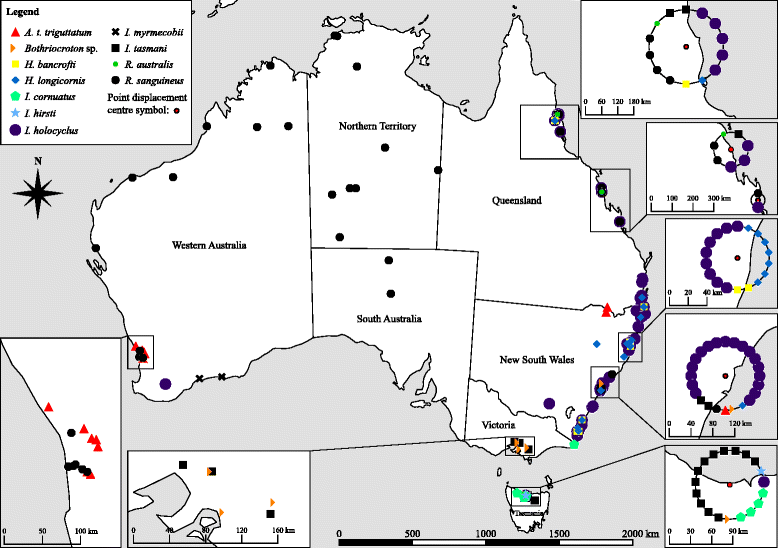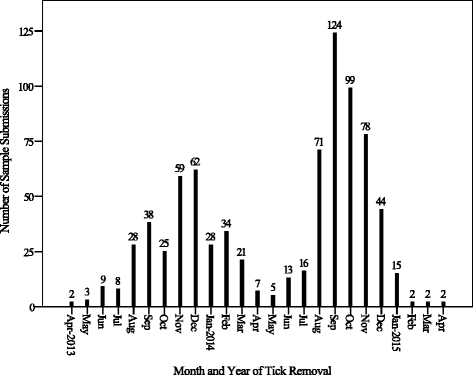A survey of ticks (Acari: Ixodidae) of companion animals in Australia
- PMID: 27160149
- PMCID: PMC4862205
- DOI: 10.1186/s13071-016-1480-y
A survey of ticks (Acari: Ixodidae) of companion animals in Australia
Abstract
Background: Ticks are among the most important vectors of pathogens affecting companion animals, and also cause health problems such as tick paralysis, anaemia, dermatitis, and secondary infections. Twenty ixodid species have previously been recorded on dogs, cats, and horses in Australia, including Rhipicephalus sanguineus, Ixodes holocyclus and Haemaphysalis longicornis, which transmit tick-borne diseases. A survey of hard ticks (Acari: Ixodidae) was conducted during 2012-2015 to investigate tick species that infest dogs, cats, and horses in Australia.
Methods: Individual tick specimens were collected from dogs, cats and horses across Australia and sample collection locations were mapped using QGIS software. Ticks were morphologically examined to determine species, instar and sex. The companion animal owners responded to questionnaires and data collected were summarised with SPSS software.
Results: A total of 4765 individual ticks were identified in this study from 7/8 states and territories in Australia. Overall, 220 larvae, 805 nymphs, 1404 males, and 2336 females of 11 tick species were identified from 837 companion animal hosts. One novel host record was obtained during this study for Ixodes myrmecobii, which was found on Felis catus (domestic cat) in the town of Esperance, Western Australia. The most common tick species identified included R. sanguineus on dogs (73 %), I. holocyclus on cats (81 %) and H. longicornis on horses (60 %).
Conclusions: This study is the first of its kind to be conducted in Australia and our results contribute to the understanding of the species and distribution of ticks that parasitise dogs, cats, and horses in Australia. Records of R. sanguineus outside of the recorded distribution range emphasise the need for a systematic study of the habitat range of this species. Several incomplete descriptions of ixodid species encountered in this study hindered morphological identification.
Keywords: Australia; Cats; Companion animals; Dogs; Horses; Tick-borne diseases; Ticks.
Figures


Similar articles
-
Endemic, exotic and novel apicomplexan parasites detected during a national study of ticks from companion animals in Australia.Parasit Vectors. 2018 Mar 20;11(1):197. doi: 10.1186/s13071-018-2775-y. Parasit Vectors. 2018. PMID: 29558984 Free PMC article.
-
Dominance of Dermacentor reticulatus over Ixodes ricinus (Ixodidae) on livestock, companion animals and wild ruminants in eastern and central Poland.Exp Appl Acarol. 2015 May;66(1):83-101. doi: 10.1007/s10493-015-9889-0. Epub 2015 Feb 26. Exp Appl Acarol. 2015. PMID: 25717007 Free PMC article.
-
Ticks associated with domestic dogs and cats in Florida, USA.Exp Appl Acarol. 2016 May;69(1):87-95. doi: 10.1007/s10493-016-0019-4. Epub 2016 Feb 18. Exp Appl Acarol. 2016. PMID: 26888081
-
Ticks infesting dogs and cats in North America: Biology, geographic distribution, and pathogen transmission.Vet Parasitol. 2021 Jun;294:109392. doi: 10.1016/j.vetpar.2021.109392. Epub 2021 Feb 19. Vet Parasitol. 2021. PMID: 33971481 Free PMC article. Review.
-
Review of ticks attacking domestic dogs and cats, and their epidemiological role in the transmission of tick-borne pathogens in Poland.Ann Agric Environ Med. 2023 Mar 31;30(1):22-30. doi: 10.26444/aaem/161552. Epub 2023 Mar 7. Ann Agric Environ Med. 2023. PMID: 36999852 Review.
Cited by
-
Active surveillance of pathogens from ticks collected in New York State suburban parks and schoolyards.Zoonoses Public Health. 2020 Sep;67(6):684-696. doi: 10.1111/zph.12749. Epub 2020 Jul 22. Zoonoses Public Health. 2020. PMID: 32697888 Free PMC article.
-
Efficacy of combination products containing sarolaner, moxidectin and pyrantel (Simparica Trio™) or afoxolaner and milbemycin (NexGard Spectra®) against induced infestations of Ixodes holocyclus in dogs.Parasit Vectors. 2020 Sep 5;13(1):448. doi: 10.1186/s13071-020-04323-8. Parasit Vectors. 2020. PMID: 32891172 Free PMC article.
-
Endemic, exotic and novel apicomplexan parasites detected during a national study of ticks from companion animals in Australia.Parasit Vectors. 2018 Mar 20;11(1):197. doi: 10.1186/s13071-018-2775-y. Parasit Vectors. 2018. PMID: 29558984 Free PMC article.
-
Hard Ticks as Vectors: The Emerging Threat of Tick-Borne Diseases in India.Pathogens. 2024 Jul 2;13(7):556. doi: 10.3390/pathogens13070556. Pathogens. 2024. PMID: 39057783 Free PMC article. Review.
-
Importation of Ticks on Companion Animals and the Risk of Spread of Tick-Borne Diseases to Non-Endemic Regions in Europe.Animals (Basel). 2020 Dec 22;11(1):6. doi: 10.3390/ani11010006. Animals (Basel). 2020. PMID: 33375145 Free PMC article.
References
-
- Cito F, Rijks J, Rantsios AT, Cunningham AA, Baneth G, Guardabassi L, et al. Prioritization of companion animal transmissible diseases for policy intervention in Europe. J Comp Pathol. 2015. In press. - PubMed
Publication types
MeSH terms
LinkOut - more resources
Full Text Sources
Other Literature Sources
Miscellaneous

